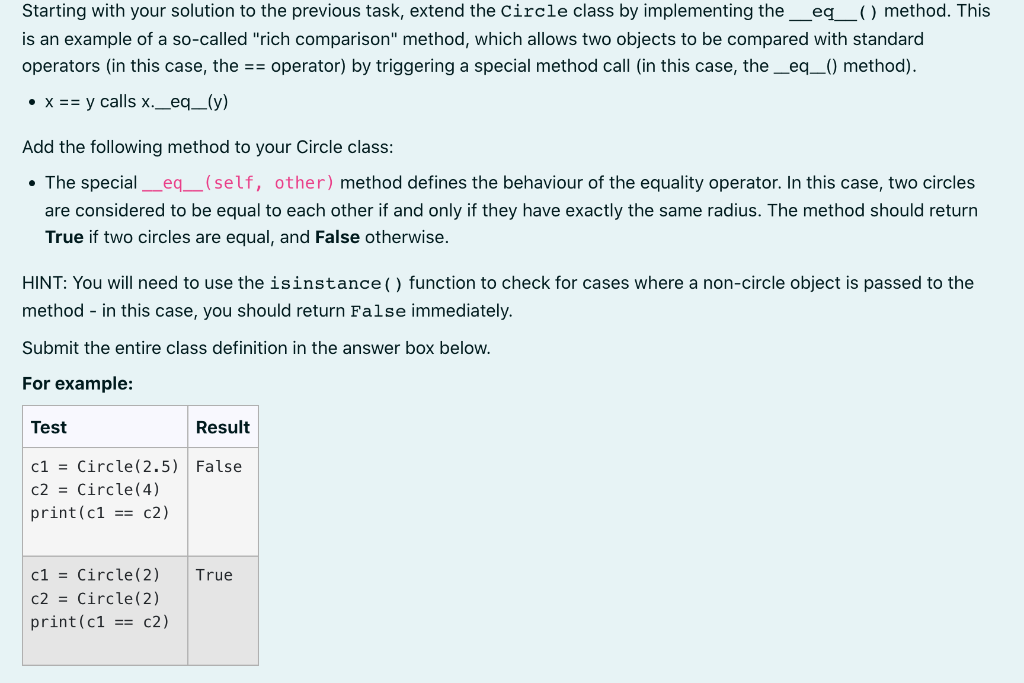Starting with your solution to the previous task, extend the Circle class by implementing the_eq__() method. This is an example of a so-called "rich comparison" method, which allows two objects to be compared with standard operators (in this case, the == operator) by triggering a special method call (in this case, the_eq_() method). • x == y calls x._eq__(y) Add the following method to your Circle class: • The special eq__(self, other) method defines the behaviour of the equality operator. In this case, two circles are considered to be equal to each other if and only if they have exactly the same radius. The method should return True if two circles are equal, and False otherwise. HINT: You will need to use the isinstance( ) function to check for cases where a non-circle object is passed to the method - in this case, you should return False immediately. Submit the entire class definition in the answer box below. For example: Test Result c1 = Circle(2.5) False c2 = Circle(4) print(c1 == c2) c1 = Circle(2) c2 = Circle(2) True print(c1 == c2)
Starting with your solution to the previous task, extend the Circle class by implementing the_eq__() method. This is an example of a so-called "rich comparison" method, which allows two objects to be compared with standard operators (in this case, the == operator) by triggering a special method call (in this case, the_eq_() method). • x == y calls x._eq__(y) Add the following method to your Circle class: • The special eq__(self, other) method defines the behaviour of the equality operator. In this case, two circles are considered to be equal to each other if and only if they have exactly the same radius. The method should return True if two circles are equal, and False otherwise. HINT: You will need to use the isinstance( ) function to check for cases where a non-circle object is passed to the method - in this case, you should return False immediately. Submit the entire class definition in the answer box below. For example: Test Result c1 = Circle(2.5) False c2 = Circle(4) print(c1 == c2) c1 = Circle(2) c2 = Circle(2) True print(c1 == c2)
Database System Concepts
7th Edition
ISBN:9780078022159
Author:Abraham Silberschatz Professor, Henry F. Korth, S. Sudarshan
Publisher:Abraham Silberschatz Professor, Henry F. Korth, S. Sudarshan
Chapter1: Introduction
Section: Chapter Questions
Problem 1PE
Related questions
Question

Transcribed Image Text:Starting with your solution to the previous task, extend the Circle class by implementing the_eq__( ) method. This
is an example of a so-called "rich comparison" method, which allows two objects to be compared with standard
operators (in this case, the == operator) by triggering a special method call (in this case, the_eq_() method).
• x == y calls x._eq_(y)
Add the following method to your Circle class:
• The special
eq_ (self, other) method defines the behaviour of the equality operator. In this case, two circles
are considered to be equal to each other if and only if they have exactly the same radius. The method should return
True if two circles are equal, and False otherwise.
HINT: You will need to use the isinstance() function to check for cases where a non-circle object is passed to the
method - in this case, you should return False immediately.
Submit the entire class definition in the answer box below.
For example:
Test
Result
c1 = Circle(2.5) False
c2 = Circle(4)
print(c1 == c2)
c1 = Circle(2)
c2 = Circle(2)
print(c1 == c2)
True
Expert Solution
This question has been solved!
Explore an expertly crafted, step-by-step solution for a thorough understanding of key concepts.
Step by step
Solved in 2 steps with 1 images

Knowledge Booster
Learn more about
Need a deep-dive on the concept behind this application? Look no further. Learn more about this topic, computer-science and related others by exploring similar questions and additional content below.Recommended textbooks for you

Database System Concepts
Computer Science
ISBN:
9780078022159
Author:
Abraham Silberschatz Professor, Henry F. Korth, S. Sudarshan
Publisher:
McGraw-Hill Education

Starting Out with Python (4th Edition)
Computer Science
ISBN:
9780134444321
Author:
Tony Gaddis
Publisher:
PEARSON

Digital Fundamentals (11th Edition)
Computer Science
ISBN:
9780132737968
Author:
Thomas L. Floyd
Publisher:
PEARSON

Database System Concepts
Computer Science
ISBN:
9780078022159
Author:
Abraham Silberschatz Professor, Henry F. Korth, S. Sudarshan
Publisher:
McGraw-Hill Education

Starting Out with Python (4th Edition)
Computer Science
ISBN:
9780134444321
Author:
Tony Gaddis
Publisher:
PEARSON

Digital Fundamentals (11th Edition)
Computer Science
ISBN:
9780132737968
Author:
Thomas L. Floyd
Publisher:
PEARSON

C How to Program (8th Edition)
Computer Science
ISBN:
9780133976892
Author:
Paul J. Deitel, Harvey Deitel
Publisher:
PEARSON

Database Systems: Design, Implementation, & Manag…
Computer Science
ISBN:
9781337627900
Author:
Carlos Coronel, Steven Morris
Publisher:
Cengage Learning

Programmable Logic Controllers
Computer Science
ISBN:
9780073373843
Author:
Frank D. Petruzella
Publisher:
McGraw-Hill Education